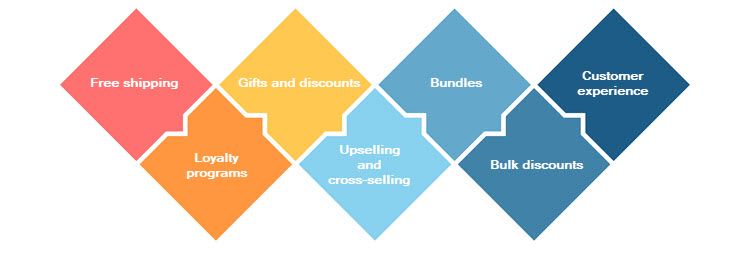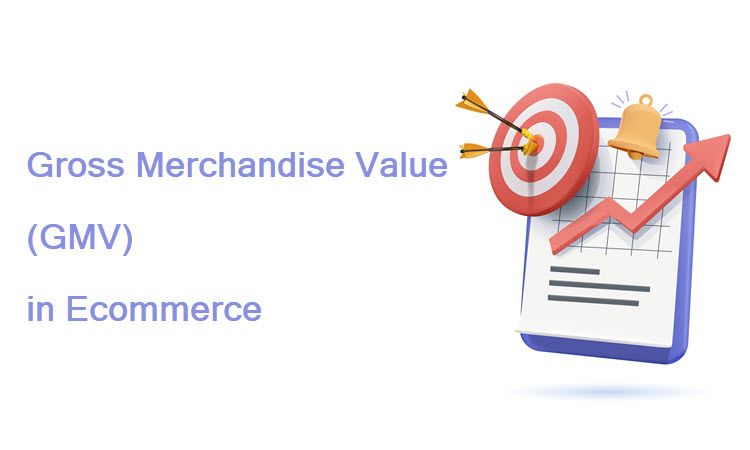The success of an ecommerce business is measured with ecommerce KPIs that analyze sales growth. Gross merchandise value (GMV) is an ecommerce metric that assesses how well a business is performing in the market.
Calculating GMV on a monthly, quarterly, or annual basis provides insight into a company’s financial health. However, it needs to be considered alongside other important factors.
Learn how to calculate gross merchandise value (GMV), what advantages this brings and what the possible pitfalls are.
What Is GMV (Gross Merchandise Value)?
GMV, or gross merchandise value, is the value of goods and services sold during a certain time frame via a single marketplace. It is typically calculated on a quarterly or annual basis. The results are then compared to the results from the previous comparable period to determine business success.
GMV is a valuable metric especially for ecommerce retailers and C2C businesses (e.g., Amazon, eBay, Etsy). By calculating GMV a business establishes the value and volume of all the sales made during a period.
It is important to note that GMV does not include expenses such as advertising, delivery, returns, and discounts. That is why this metric must not be taken as the sole indicator of profitability. For a more complete picture of the success of a business, other factors should also be considered.
How to Calculate Gross Merchandise Value?
Gross merchandise value is calculated by multiplying the sales price by the number of goods sold to customers.

For example, if a business sells 10 jackets priced at $200 each, GMV is $2000.
GMV vs. Revenue
Although sometimes used interchangeably, GMV and revenue are not the same thing. Since gross merchandise value is calculated before deducting the cost of selling a product, this value does not reflect the business’s revenue.
Take Amazon for example - the retailing giant’s GMV shows the total value of goods sold on its website. However, Amazon’s actual revenue is a portion of this value and comes from the fees the company collects from sellers.
In the case of an ecommerce site selling its own product, GMV will come closer to reflecting revenue because everything the customer pays goes directly to the business.
GMV vs. ARR
Annual recurring revenue (ARR) is a metric that shows how much recurring revenue a subscription business can expect in 12 months. ARR is an applicable metric for subscription business models because it excludes one-time payments and fees.
Besides the obvious differences, GMV can be calculated for different time periods. It is the more valuable metric for an ecommerce business that mostly deals with one-time payments.
Note: Learn about different types of SaaS subscription business models in our article How to Shape Your SaaS Subscription Business Model.
Why Is Gross Merchandise Value Important?
GMV is an effective metric for comparing the value of sales an ecommerce business has made during different periods. As such, it is a good indicator of a company’s growth and financial health.
GMV helps determine if goals are being fulfilled and which part of the process could use some improvement. By regularly measuring the volume and value of transactions handled, a merchant can act quickly and implement solutions that increase sales.
Because GMV establishes the value of sales, it is one of the key indicators of market demand for a product, giving insight into the company’s business potential. It also helps quantify the market traction (attractiveness to investors) of a company and its projected future growth.
Disadvantages of GMV
The main feature of GMV is that the data it provides is raw. This means that it does not factor in other KPIs that determine a business’s profitability.
Here are some of the pitfalls of relying only on GMV to assess a company’s success:
- Does not include expenses. GMV does not take into account the costs of production, purchase, marketing and other expenses, including returns, discounts, or delivery fees.
- Gives an inaccurate product value. Although GMV represents the value of your overall sales, the actual value of each product is not reflected in this metric. Focusing too much on GMV can tempt merchants to neglect cheaper products in favor of high-value goods, which tend to have lower profit margins.
- Only gives part of the picture. On its own, GMV does not correctly reflect the financial health of a company. To avoid getting a false picture of the financial health of your ecommerce business, consider these crucial factors:
- Conversion rate (CVR)
- Churn rate
- Average order value (AOV)
- Cart abandonment rate
- Net Merchandise Value (NMV)
- Customer Acquisition Cost (CAC)
- Profit Margin per Product (PMpP)
- Repeat customers
Note: Learn more about markup percentage and gross profit margin, two important accounting terms.
How to Increase GMV?

Most solutions that optimize conversion rates will result also in greater GMV. However, there are other strategies that help to increase sales volumes:
- Offer free shipping. Free shipping is a great way to increase GMV, as long your business can afford it. Offer free shipping after a set number of purchases, for purchases above a certain price, or during special periods.
- Reward loyalty. Loyalty programs stimulate sales by rewarding customers who make repeated purchases or recommend the brand to a friend.
- Offer gifts and discounts. Gift cards, special promo codes, and discounts incentivize customers to make a new purchase or finalize a previous one, reducing cart abandonment rates.
- Upsell and cross-sell. Upselling is encouraging the customers to upgrade their purchase with a better version of a product. With cross-selling customers are offered additional, lower-value products that go well with the original purchase.
- Utilize bundles. Product bundling allows customers to purchase groups of products that cost more if bought separately. A good example of bundling is a McDonald’s meal.
- Give bulk discounts. Encourage bulk purchases by offering customers special discounts.
- Enhance the customer experience From the initial search to the checkout process, and how issues were handled, customers remember how they felt when shopping at your online store. Every effort you make in this area will positively impact your bottom line and raise your GMV.
Conclusion
Gross merchandise value is a metric that shows whether your business is growing and thriving. Calculating your GMV is a way to compare sales over different time periods and knowing your GMV helps you assess business goals and plan for the future.
Remember that GMV does not accurately reflect profitability. For a more granulated evaluation of the financial health of your business, combine GMV with other ecommerce KPIs.
